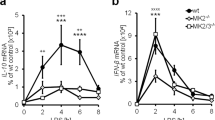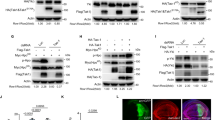Abstract
Mitogen-activated protein kinases facilitate many cellular processes and are essential for immune cell function. Their activity is controlled by kinases and dual-specificity phosphatases. A comprehensive microarray analysis of human leukocytes identified DUSP2 (encoding the phosphatase PAC-1) as one of the most highly induced transcripts in activated immune cells. We generated Dusp2−/− mice and found considerably reduced inflammatory responses in the 'K/BxN' model of rheumatoid arthritis. PAC-1 deficiency led to increased activity of Jun kinase (Jnk) but unexpected impairment of the activity of extracellular signal–regulated kinase (Erk) and the kinase p38, reduced activity of the transcription factor Elk1 and a complex of mobilized transcription factor NFAT and the AP-1 transcription factor and decreased effector immune cell function. Thus, PAC-1 is a key positive regulator of inflammatory cell signaling and effector functions, mediated through Jnk and Erk mitogen-activated protein kinase crosstalk.
This is a preview of subscription content, access via your institution
Access options
Subscribe to this journal
Receive 12 print issues and online access
$209.00 per year
only $17.42 per issue
Buy this article
- Purchase on Springer Link
- Instant access to full article PDF
Prices may be subject to local taxes which are calculated during checkout







Similar content being viewed by others
References
Dong, C., Davis, R.J. & Flavell, R.A. MAP kinases in the immune response. Annu. Rev. Immunol. 20, 55–72 (2002).
Chang, L. & Karin, M. Mammalian MAP kinase signalling cascades. Nature 410, 37–40 (2001).
Robinson, M.J. & Cobb, M.H. Mitogen-activated protein kinase pathways. Curr. Opin. Cell Biol. 9, 180–186 (1997).
Mahtani, K.R. et al. Mitogen-activated protein kinase p38 controls the expression and posttranslational modification of tristetraprolin, a regulator of tumor necrosis factor α mRNA stability. Mol. Cell. Biol. 21, 6461–6469 (2001).
Dumitru, C.D. et al. TNF-α induction by LPS is regulated posttranscriptionally via a Tpl2/ERK-dependent pathway. Cell 103, 1071–1083 (2000).
Camps, M., Nichols, A. & Arkinstall, S. Dual specificity phosphatases: a gene family for control of MAP kinase function. FASEB J. 14, 6–16 (2000).
Zhang, Y. et al. Regulation of innate and adaptive immune responses by MAP kinase phosphatase 5. Nature 430, 793–797 (2004).
Chu, Y., Solski, P.A., Khosravi-Far, R., Der, C.J. & Kelly, K. The mitogen-activated protein kinase phosphatases PAC1, MKP-1, and MKP-2 have unique substrate specificities and reduced activity in vivo toward the ERK2 sevenmaker mutation. J. Biol. Chem. 271, 6497–6501 (1996).
Ward, Y. et al. Control of MAP kinase activation by the mitogen-induced threonine/tyrosine phosphatase PAC1. Nature 367, 651–654 (1994).
Karlsson, M., Mathers, J., Dickinson, R.J., Mandl, M. & Keyse, S.M. Both nuclear-cytoplasmic shuttling of the dual specificity phosphatase MKP-3 and its ability to anchor MAP kinase in the cytoplasm are mediated by a conserved nuclear export signal. J. Biol. Chem. 279, 41882–41891 (2004).
Masuda, K., Shima, H., Watanabe, M. & Kikuchi, K. MKP-7, a novel mitogen-activated protein kinase phosphatase, functions as a shuttle protein. J. Biol. Chem. 276, 39002–39011 (2001).
Theodosiou, A. & Ashworth, A. MAP kinase phosphatases. Genome Biol. 3, 3009.1–3009.10 (2002).
Keyse, S.M. Protein phosphatases and the regulation of mitogen-activated protein kinase signalling. Curr. Opin. Cell Biol. 12, 186–192 (2000).
Dorfman, K. et al. Disruption of the erp/mkp-1 gene does not affect mouse development: normal MAP kinase activity in ERP/MKP-1-deficient fibroblasts. Oncogene 13, 925–931 (1996).
Zhao, Q. et al. The role of mitogen-activated protein kinase phosphatase-1 in the response of alveolar macrophages to lipopolysaccharide: attenuation of proinflammatory cytokine biosynthesis via feedback control of p38. J. Biol. Chem. 280, 8101–8108 (2005).
Zhao, Q. et al. MAP kinase phosphatase 1 controls innate immune responses and suppresses endotoxic shock. J. Exp. Med. 203, 131–140 (2006).
Hammer, M. et al. Dual specificity phosphatase 1 (DUSP1) regulates a subset of LPS-induced genes and protects mice from lethal endotoxin shock. J. Exp. Med. 203, 15–20 (2006).
Christie, G.R. et al. The dual-specificity protein phosphatase DUSP9/MKP-4 is essential for placental Function but is not required for normal embryonic development. Mol. Cell. Biol. 25, 8323–8333 (2005).
Rohan, P.J. et al. PAC-1: A mitogen-induced nuclear protein tyrosine phosphatase. Science 259, 1763–1766 (1993).
Grumont, R.J., Rasko, J.E., Strasser, A. & Gerondakis, S. Activation of the mitogen-activated protein kinase pathway induces transcription of the PAC-1 phosphatase gene. Mol. Cell. Biol. 16, 2913–2921 (1996).
Rohan, P.J. et al. PAC-1: a mitogen-induced nuclear protein tyrosine phosphatase. Science 259, 1763–1766 (1993).
Yin, Y., Liu, Y.X., Jin, Y.J., Hall, E.J. & Barrett, J.C. PAC1 phosphatase is a transcription target of p53 in signalling apoptosis and growth suppression. Nature 422, 527–531 (2003).
Kouskoff, V. et al. Organ-specific disease provoked by systemic autoimmunity. Cell 87, 811–822 (1996).
Lee, D.M. et al. Mast cells: a cellular link between autoantibodies and inflammatory arthritis. Science 297, 1689–1692 (2002).
Solomon, S., Rajasekaran, N., Jeisy-Walder, E., Snapper, S.B. & Illges, H. A crucial role for macrophages in the pathology of K/B × N serum-induced arthritis. Eur. J. Immunol. 35, 3064–3073 (2005).
Ji, H. et al. Arthritis critically dependent on innate immune system players. Immunity 16, 157–168 (2002).
Kouskoff, V. et al. Organ-specific disease provoked by sytemic autoimmunity. Cell 87, 811–822 (1996).
Farooq, A. et al. Solution structure of the MAPK phosphatase PAC-1 catalytic domain. Insights into substrate-induced enzymatic activation of MKP. Structure (Camb) 11, 155–164 (2003).
Morita, S., Kojima, T. & Kitamura, T. Plat-E: an efficient and stable system for transient packaging of retroviruses. Gene Ther. 7, 1063–1066 (2000).
Pouyssegur, J. & Lenormand, P. Fidelity and spatio-temporal control in MAP kinase (ERKs) signalling. Eur. J. Biochem. 270, 3291–3299 (2003).
Franklin, C.C., Srikanth, S. & Kraft, A.S. Conditional expression of mitogen-activated protein kinase phosphatase-1, MKP-1, is cytoprotective against UV-induced apoptosis. Proc. Natl. Acad. Sci. USA 95, 3014–3019 (1998).
Saccani, S., Pantano, S. & Natoli, G. p38-Dependent marking of inflammatory genes for increased NF-κB recruitment. Nat. Immunol. 3, 69–75 (2002).
Frost, J.A. et al. Cross-cascade activation of ERKs and ternary complex factors by Rho family proteins. EMBO J. 16, 6426–6438 (1997).
Avots, A. et al. CBP/p300 integrates Raf/Rac-signaling pathways in the transcriptional induction of NF-ATc during T cell activation. Immunity 10, 515–524 (1999).
Boise, L.H. et al. The NFAT-1 DNA binding complex in activated T cells contains Fra-1 and JunB. Mol. Cell. Biol. 13, 1911–1919 (1993).
Shen, Y.H. et al. Cross-talk between JNK/SAPK and ERK/MAPK pathways: sustained activation of JNK blocks ERK activation by mitogenic factors. J. Biol. Chem. 278, 26715–26721 (2003).
Tanoue, T., Yamamoto, T. & Nishida, E. Modular structure of a docking surface on MAPK phosphatases. J. Biol. Chem. 277, 22942–22949 (2002).
Firestein, G.S. Evolving concepts of rheumatoid arthritis. Nature 423, 356–361 (2003).
Ji, H. et al. Critical roles for interleukin 1 and tumor necrosis factor α in antibody-induced arthritis. J. Exp. Med. 196, 77–85 (2002).
Kohno, M., Yamasaki, S., Tybulewicz, V.L. & Saito, T. Rapid and large amount of autocrine IL-3 production is responsible for mast cell survival by IgE in the absence of antigen. Blood 105, 2059–2065 (2005).
Harada, H., Quearry, B., Ruiz-Vela, A. & Korsmeyer, S.J. Survival factor-induced extracellular signal-regulated kinase phosphorylates BIM, inhibiting its association with BAX and proapoptotic activity. Proc. Natl. Acad. Sci. USA 101, 15313–15317 (2004).
Kamata, H. et al. Reactive oxygen species promote TNFα-induced death and sustained JNK activation by inhibiting MAP kinase phosphatases. Cell 120, 649–661 (2005).
Lei, K. et al. The Bax subfamily of Bcl2-related proteins is essential for apoptotic signal transduction by c-Jun NH2-terminal kinase. Mol. Cell. Biol. 22, 4929–4942 (2002).
Xiao, Y.Q. et al. Cross-talk between ERK and p38 MAPK mediates selective suppression of pro-inflammatory cytokines by transforming growth factor-β. J. Biol. Chem. 277, 14884–14893 (2002).
Shen, Y. et al. Activation of the Jnk signaling pathway by a dual-specificity phosphatase, JSP-1. Proc. Natl. Acad. Sci. USA 98, 13613–13618 (2001).
Chen, A.J. et al. The dual specificity JKAP specifically activates the c-Jun N-terminal kinase pathway. J. Biol. Chem. 277, 36592–36601 (2002).
Chtanova, T. et al. T follicular helper cells express a distinctive transcriptional profile, reflecting their role as non-Th1/Th2 effector cells that provide help for B cells. J. Immunol. 173, 68–78 (2004).
McBurney, M.W. et al. The mouse xioa gene promoter contains an upstream activator sequence. Nucleic Acids Res. 19, 5755–5761 (1991).
Kontgen, F. & Stewart, C.L. Simple screening procedure to detect gene targeting events in embryonic stem cells. Methods Enzymol. 225, 878–890 (1993).
Ochi, H. et al. T helper cell type 2 cytokine-mediated comitogenic responses and CCR3 expression during differentiation of human mast cells in vitro. J. Exp. Med. 190, 267–280 (1999).
Irizarry, R.A. et al. Exploration, normalization, and summaries of high density oligonucleotide array probe level data. Biostatistics 4, 249–264 (2003).
Bowles, N.E., Eisensmith, R.C., Mohuiddin, R., Pyron, M. & Woo, S.L. A simple and efficient method for the concentration and purification of recombinant retrovirus for increased hepatocyte transduction in vivo. Hum. Gene Ther. 7, 1735–1742 (1996).
Durand, D.B. et al. Characterization of antigen receptor response elements within the interleukin-2 enhancer. Mol. Cell. Biol. 8, 1715–1724 (1988).
Acknowledgements
We thank R. Daly for suggestions; D. Mathis (Harvard Medical School, Boston, Massachusetts) and C. Benoist for supplying KRN mice; R. Newton and C. Waltzinger for flow cytometry assistance; J. Thatcher and D. Zhara for PAC-1 antibodies; W. Kaplan for statistical assistance with mast cell GeneChip data; and T. Kitamura for Plat-E cells, pMx vector and technical advice on retroviral transductions. C.R.M. and S.D.G. share senior authorship. Supported by National Health and Medical Research Council of Australia and the Cooperative Research Center for Asthma.
Author information
Authors and Affiliations
Corresponding authors
Ethics declarations
Competing interests
Garvan Institute has submitted a patent application that has been licensed by G2 Therapies, a company C.R.M. founded and has a financial interest in.
Supplementary information
Supplementary Fig. 1
PAC-1 is hematopoietic cell-specific in its expression. (PDF 25 kb)
Supplementary Fig. 2
Selected PAC-1 monoclonal antibodies show good selectivity towards PAC-1 over other related DUSPs and other phosphatases. (PDF 65 kb)
Supplementary Fig. 3
Genechip expression profiling of DUSPs in mouse leukocytes, qPCR of pac-1 mRNA and immunoblot of PAC-1 in primary immune cells. (PDF 72 kb)
Supplementary Fig. 4
Targeted deletion of mouse Pac1 gene results in protection of Pac1−/− mice in the K/BxN model of rheumatoid arthritis. (PDF 185 kb)
Supplementary Fig. 5
Pac1+/+ and Pac1−/− BMMCs have comparable physical and functional properties. (PDF 40 kb)
Supplementary Fig. 6
Further analysis of the differential expression of signal transducers and transcription factors between wild-type and PAC-1 deficient activated macrophages and mast cells. (PDF 192 kb)
Supplementary Fig. 7
Elk-1 activity is dependent on ERK activity and inhibition of both ERK and p38 can eliminate TNF and IL-4 production in BMMCs. (PDF 24 kb)
Rights and permissions
About this article
Cite this article
Jeffrey, K., Brummer, T., Rolph, M. et al. Positive regulation of immune cell function and inflammatory responses by phosphatase PAC-1. Nat Immunol 7, 274–283 (2006). https://doi.org/10.1038/ni1310
Received:
Accepted:
Published:
Issue Date:
DOI: https://doi.org/10.1038/ni1310
This article is cited by
-
Bioinformatic analysis and experimental validation of the potential gene in the airway inflammation of steroid-resistant asthma
Scientific Reports (2023)
-
DUSP1 mediates BCG induced apoptosis and inflammatory response in THP-1 cells via MAPKs/NF-κB signaling pathway
Scientific Reports (2023)
-
Variability in donor leukocyte counts confound the use of common RNA sequencing data normalization strategies in transcriptomic biomarker studies performed with whole blood
Scientific Reports (2023)
-
Gastric cancer-derived exosomal miR-519a-3p promotes liver metastasis by inducing intrahepatic M2-like macrophage-mediated angiogenesis
Journal of Experimental & Clinical Cancer Research (2022)
-
The aberrant cross-talk of epithelium–macrophages via METTL3-regulated extracellular vesicle miR-93 in smoking-induced emphysema
Cell Biology and Toxicology (2022)



